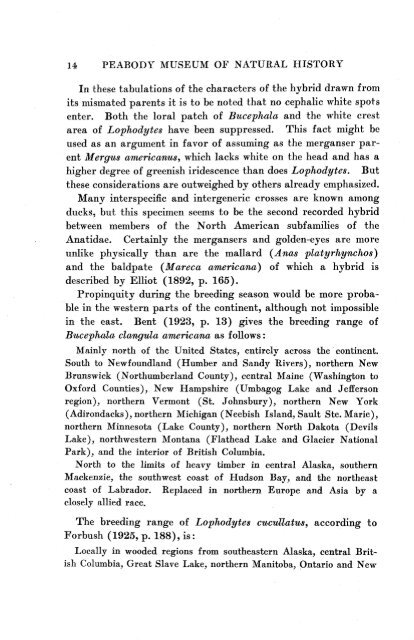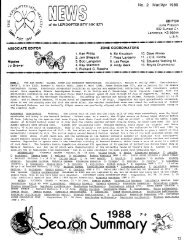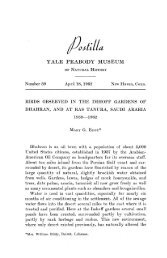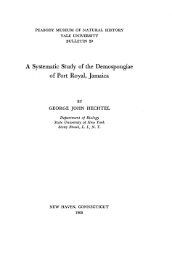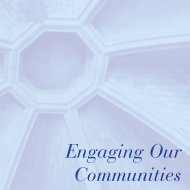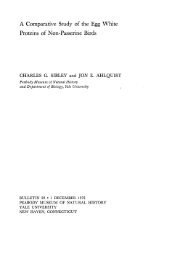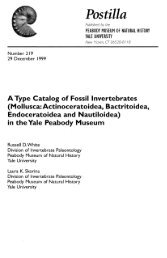Bulletin 3 - Peabody Museum of Natural History - Yale University
Bulletin 3 - Peabody Museum of Natural History - Yale University
Bulletin 3 - Peabody Museum of Natural History - Yale University
Create successful ePaper yourself
Turn your PDF publications into a flip-book with our unique Google optimized e-Paper software.
14 PEABODY MUSEUM OF NATURAL HISTORYIn these tabulations <strong>of</strong> the characters <strong>of</strong> the hybrid drawn fromits mismated parents it is to be noted that no cephalic white spotsenter. Both the loral patch <strong>of</strong> Bucephala and the white crestarea <strong>of</strong> Lophodytes have been suppressed. This fact might beused as an argument in favor <strong>of</strong> assuming as the merganser parentMergus americarms, which lacks white on the head and has ahigher degree <strong>of</strong> greenish iridescence than does Lophodytes. Butthese considerations are outweighed by others already emphasized.Many interspecific and intergeneric crosses are known amongducks, but this specimen seems to be the second recorded hybridbetween members <strong>of</strong> the North American subfamilies <strong>of</strong> theAnatidae. Certainly the mergansers and golden-eyes are moreunlike physically than are the mallard {Anas platyrhynchos)and the baldpate (Mareca americana) <strong>of</strong> which a hybrid isdescribed by Elliot (1892, p. 165).Propinquity during the breeding season would be more probablein the western parts <strong>of</strong> the continent, although not impossiblein the east. Bent (1923, p. 13) gives the breeding range <strong>of</strong>Bucephala clangula americana as follows:Mainly north <strong>of</strong> the United States, entirely across the continent.South to Newfoundland (Humber and Sandy Rivers), northern NewBrunswick (Northumberland County), central Maine (Washington toOxford Counties), New Hampshire (Umbagog Lake and Jeffersonregion), northern Vermont (St. Johnsbury), northern New York(Adirondacks), northern Michigan (Neebish Island, Sault Ste. Marie),northern Minnesota (Lake County), northern North Dakota (DevilsLake), northwestern Montana (Flathead Lake and Glacier NationalPark), and the interior <strong>of</strong> British Columbia.North to the limits <strong>of</strong> heavy timber in central Alaska, southernMackenzie, the southwest coast <strong>of</strong> Hudson Bay, and the northeastcoast <strong>of</strong> Labrador. Replaced in northern Europe and Asia by aclosely allied race.The breeding range <strong>of</strong> Lophodytes cucullatus, according toForbush (1925, p. 188), is:Locally in wooded regions from southeastern Alaska, central BritishColumbia, Great Slave Lake, northern Manitoba, Ontario and New


